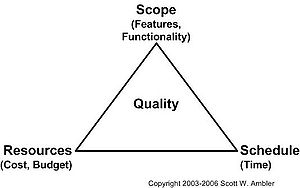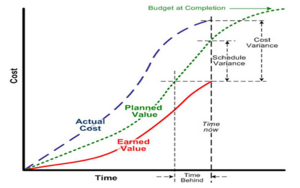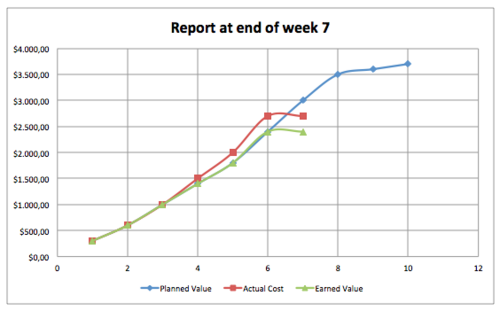Earned Value Management (EVM) in construction projects
The Us federal government introduced Earned Value management(EVM) in 1967 as a part of the cost/schedule control systems criteria (C/SCSC) to understand the financial aspects of programs and to be used in acquisition programs of large degree in an attempt to generate a consistent method based on best practices. Earned Value management and methods that vary from EVM to a small degree have been used under handful of names, including earned value project management, earned value analysis, earned value method and cost/schedule summary reporting. Earned Value management is a systematic process that is used to measure the performance of a project at different times throughout the life cycle of a project. EVM is useful to help project managers or people in general that are responsible for a project to determine whether a project is on schedule, or if the project is over or under budget. EVM can also be used to compare the actual work that has been performed to the work that was estimated and planned for the project at a certain time during the project, EVM can also be used to forecast projected performance. EVM is a technique that can be applied, to at least some degree, to the management of projects in any industry and using any contracting approach. [1]
EVM measures project progress and performance by the integrated management of three fundamental elements of project management, cost, schedule and scope which make up the Project Management Triangle as can be seen in figure 1.

In most cases in practice, the progress of an project is evaluated by comparing it against earned value indices and estimates against historically values, past projects or according to numerous criterias http://production.datastore.cvt.dk/filestore?oid=53a7918e4ad04bb77203f099&targetid=53a7918e4ad04bb77203f09b
Contents |
History
Concept overview
Implementation of the method
Steps to EVM
In this sector there will be an simplification of the steps that need to be taken in EVM, this is done since each of the step is quite comprehensive and each and every one could be an article on its own.
step 1-5 is before the project starts
step 1. Building the foundation for the project - this step is about deconstructing the project Statement of Work(SOW) into more discrete, measurable components to develop the Work Breakdown Structure(WBS) and the tasks/activities that are essential to execute the work
step 2. Determine the resources and effort required to execute the work. This is an estimation, and it can provide useful for the company to use previous projects that have been similar to make the estimations.
step 3. Make up a Resource leaded schedule of the time that it is expected to take executing the work
step 4. Define a methodology to measure activity/task completion that suits the project (EV methods)
step 5. This steps is about pricing the resources and efforts that are expected to be used during the project, this is done to make a project budget (Budgeted Cost of Work Scheduled or Planned value)
step 6-10 is after the project has begun
step 6. Now the project has begun and in this step the actual cost(AC) of work performed by period is collected against the WBS below the level required for reporting. step 7. Using which ever methodology created in step 4, calculation are made to determine the completion percentage of an activity/task
step 8. In this step Earned Value(EV) or Budgeted Cost of work is calculated. That is achieved by multiplying the completion percentage of the task/activity against the total budget for that task/activity
step 9. In this step Schedule Variance(SV) is calculated. that is achieved by subtracting the Planned value from the Earned value(EV)
step 10.
Calculate the Cost Performance Index, which is often referred to as the cost efficiency of a project in order to calculate the Estimate at completion(EAC) which is the new projected estimated total cost at project completion given the information at time calculated.
Formula

[2]</ref>
Parameters
| Parameter | Description |
|---|---|
| Planned Value (PV) | Is a budget baseline that has been established for a project/work package/activity. It is a function of cost and time as can be seen in figure 1. PV baseline can be used to view the value to be earned at a certain time/phase in the project. PV is frequently referred to as the S curve simply because of the shape of the curve |
| Budget at completion (BAC) | BAC is the final point and the highest value of the cumulative Planned value curve. BAC represents the total budget for the project/work package/activity. |
| Actual Cost (AC) | Is the cumulative actual cost that has been spent on a project/work package/activity |
| Earned value (EV) | is the cumulative value that has been earned for the work completed at a certain point in time.
Formula: Earned value(EV)=total budget for activity*completed proportion
|
| Earned Value Variances | Description | Formula | Result |
|---|---|---|---|
| Cost Variance (CV) | The difference between the amount budgeted and the amount that was actually spent on the work performed. CV shows whether and by how much amount the project is over or under pre-approved budget | = Earned Value (EV) - Actual Cost (AC) | > 0 means under budget
< 0 means over budget |
| Schedule Variance (SV) | The difference between the amount budgeted and the amount that was planned for the project. SV is a good indicator to show if and by how much your work is behind or ahead of pre-approved schedule | = Earned Value (EV) - Planned Value (PV) | > 0 means ahead of schedule
< 0 means behind schedule |
| Earned Value Indices | Description | Formula | Result |
|---|---|---|---|
| Cost Performance Index (CPI) | The ratio of approved budget for work performed(EV) to what was actually spent on the work(AC). CPI reflect the relative value of the work that has been completed to the amount paid for the task. CPI is often reffered to as the Cost efficiency of a project | = EV/AC | > 1 means better progress for the money spent
< 1 means less progress for the money spent |
| Schedule Performance Index (SPI) | The ratio of approved budget for work performed to the actual approved budget for work performed(EV) to what was budgeted for the project(PV). SPI is useful since it reviels if the project is behind or ahead of schedule | = EV/PV | > 1 means more work performed than had been scheduled
< 1 means less work performed than had been scheduled |
| Project Percent Complete | Percent of project work complete at a given time.
Remember BAC = Budget at Completion |
= (EV/BAC) * 100 | |
| To Complete Performance Index (TCPI) | The cost performance index required to complete the project on the predetermined budget or the required future cost efficiency that is needed to achieve the target Budget at completion(BAC) | =(BAC-EV)/(BAC-AC) |
| Earned Value Forecast | Description | Formula |
|---|---|---|
| Estimate at completion (EAC) | The estimated total cost at project completion. The formula for EAC is based on the assumption that the current performance gives a fair indication of future performance | = BAC/CPI |
| Variance at completion (VAC) | The estimated variance between actual total cost(EAC) and planned total cost(BAC) at project completion. | = BAC-EAC
|
EVM Graph
The parameters above can be seen in a visual representation in figure X. It can be useful to have the numbers translated into something visual for a more simple understanding of the status of the ongoing project. Most of the necessary information can be found in the graph and visually it can be seen in the figure that:
- the Actual Cost(AC) of the project is above the predetermined Planned Value(PV) that had been established.
- The Earned Value(EV) of work completed is lower than the Planned Value
- By comparing the gaps between the Actual Cost and Earned value the Cost Variance of the project can be found. According to this figure the project is above the pre-approved budget
- By comparing the gaps between the Planned Value and Earned value the Schedule Variance of the project can be found. According to this figure the project is behind schedule
Terminology
Example
In this section there will be an short simplified example of EVM in a project that has five tasks A,B,C,D,E. Figure 1. Step 1 For each of the tasks the duration has been estimated, the cost of each task per week and finally the total cost of each task. These cost are called Planned value(PV) in EVM. In more detailed examples and projects a Work Breakdown schedule"(WBS) can be very useful if used in the right ways.
| Task | Predecessor | Duration(Weeks) | Cost/Week | Total Cost |
|---|---|---|---|---|
| A | 2 | 300 | 600 | |
| B | A | 3 | 400 | 1200 |
| C | B | 3 | 400 | 1200 |
| D | B | 2 | 200 | 400 |
| E | D | 3 | 100 | 300 |
| 3700 |
To keep track of the status of each of the projects a Gantt Chartt has proven to be very useful since it provides much needed clarity, helps with coordination and last but not least time management, helping teams understand the overall impact of project delays which is an vital part of the EVM method. In this Gantt chart there can be seen the planned schedule and the actual performance of the project up until week 7 when the project manager decided to take a closer look at the progression of the project.
His report at the end of week 7 can be seen in table 2. Using the data from that table to fill up the GANTT Chart. According to the report and from the GANT Chart it can be concluded that task C and D are behind schedule.
| Task | Planned completion | Actual completion |
|---|---|---|
| C | 66% | 33% |
| D | 100% | 50% |
Now it is time from the project manager to analyze the situation and take a closer look at the Earned Value Variances(, Earned Value Indices and Earned Value Forecast
The project manager made some calculations which can be seen in table 3.
| Task | Schedule Variance (SV) | Cost Variance(CV) | Schedule Performance Index(SPI) | Cost Performance Index(CPI) |
|---|---|---|---|---|
| A | Exactly on schedule | Exactly On budget | Exact amount of work performed that has been scheduled | Exact amount of progress for the money spent |
| B | Exactly on schedule | Over budget | Exact amount of work performed that has been scheduled | Less progress for the money spent |
| C | Behind on schedule | Over budget | 50% of work performed that has been scheduled | Less progress for the money spent |
| D | Behind on schedule | Exactly on budget | 50% of work performed that has been scheduled | Exact amount of progress for the money spent |
| E | - | - | - | - |
Advantages
The use of EVM to make progress payments on construction projects.
When undergoing a project there is often a risk that the owner of the project is going to overpay their suppliers for the work they completed. This is due to the fact that Cost-type arrangements have inherent risk for the sake of the owners focusing on the expense paid and forgetting to closely monitor the actual work done for the money spent. One way of mitigating this risk is to accurately measure the value of work completed, compare that against the original budget authorized for the completed work, and only pay for actual work completed. There are two broad contractual environments in the building industry, Cost type and fixed price
Cost type
Is often used in construction projects to cover the initial design work and both the first and final design. In project that are high risk, f.x. nuclear energy construction the cost type contract is sometimes used for all of the phases of the project.
Cost reimbursable type arrangement works in the following manner: the supplier will be refunded each month for the actual cost(AC) during the project, which is subjected to the terms of their agreement, meaning that all costs (excluding fee) are submitted by the supplier/contractor to the owner, who pays the bill. Because of this arrangements there can be a substantial difference between the physical work done and the dollars being spent on the project. Quentin W. Fleming and Joel M. Koppelman provide four recommendations to reduce the risk for cost type contracts
1. Project owners should order the supplier/constructor to provide a "schedule of values" which is time-phased, and the sum of all items will be listed up to the total contract value. This time-phased schedule provides the owner a valuable and simple form of "planned value(PV)" which can be used to measure the performance of the project through its life cycle
2. At the end of each month, when the supplier/contractor provide their invoice that reflect the Actual cost(AC) incurred, order the contractor to update their schedule of values, which is the Earned value(EV) of the project. This gives the owner a tool to monitor the earned value against the planned value and the earned value minus the actual cost to get the cost variance of the project
3. It can be useful to monitor the performance of both the cumulative Cost Performance index(CPI) and the Schedule Performance Index(SPI) to compare the results of one project to all other projects with similar circumstances in the company.
4. Forecast the likely final cost at regular intervals with the Estimate at completion (EAC) method to ensure that the project is on budget, and if it is not make the necessary adjustment to stay on track
Fixed price
In most fixed price contracts suppliers/contractors are given progress payments based on the amount of work completed, along with the authorized budget for the completed work. This method is highly useful with the Earned Value Management method. Effective method to establish an earned value baseline could be to require the supplier/contractor to make a "critical path method(CPM) LINKA CRITICAL PATH METHOD HERNA GAMLI, with the necessary resources integrated into the CPM model, and the sum of these resources must sum to 100% of the contract value. Actual costs(AC) related to the earned value are oft missing in the fixed price work. If there is no AC then we lack the ability to make up the Cost performance index(CPI), which is one of the most important indicator in the EVM method. Suppliers/contractors who accept a fixed price job are likely to be reluctant to disclose how much profit they are making on the job, actual cost to earned value. The profit that the contractor is set to make should not be concern to the project owner, it's only when the contractor starts to incur a loss, especially a large loss that the project owner could get concerned. This is due to the fact that a loss increased the likelihood that the supplier is unable to complete the job. To mitigate the risk to the owners Quentin W. Fleming and Joel M. Koppelman provide two recommendations
1. Condition all fixed price suppliers to hand over their anticipated costs that have incurred, to match with their planned value(PV) projections contained with either previously mentioned time-phased schedule of values, or their CPM resource loaded model. These costs incurred forecasts usually resemble the "S" shaped curve LINKA HERNA I S-SHAPE CURVE JAFNVEL HEIMILD FYRIR S SHAPE CURVE. Unless there are justifying reasons there forecast should resamble the "S" curve, else the projections may be "front-loaded" TILVITNUN I FRONT LOADED, or the project owner might be paying for work that has not been completed
2. To minimize the financial risk of the project, there could be a good thing to condition the supplier to have their chief financial officer(CFO) to validate each month that they have not exceeded their planned value of cost incurred. On the other hand if the supplier has exceeded their planned value , require them to reveal the amount of their actual cost incurred, so it is possible to compare it to the earned value and be able to quickly determine how much loss the contractor has suffered.
Limitations
References
- Kwak, Y. H., & Anbari, F. T. (2012). History, practices, and future of earned value management in government: Perspectives from NASA. Project Management Journal, 43(1), 77–90. doi:10.1002/pmj.20272
- BLAA
- Strategic Consulting Solutions inc. (2012). 10 Steps to Understanding Earned Value Management
[2]</ref>
Further reading
THE USE OF EARNED VALUE ANALYSIS (EVA) IN THE COST MANAGEMENT OF CONSTRUCTION PROJECTS
CRITICAL ANALYSIS ON EARNED VALUE MANAGEMENT (EVM) TECHNIQUE IN BUILDING CONSTRUCTION
file:///C:/Users/Lib1/Downloads/Candido%20et%20al.%20%202014%20-%20Critical%20Analysis%20on%20Earned%20Value%20Management%20(EVM)%20Technique%20in%20Building%20Construction%20.pdf
Cite error:
<ref> tags exist, but no <references/> tag was found




